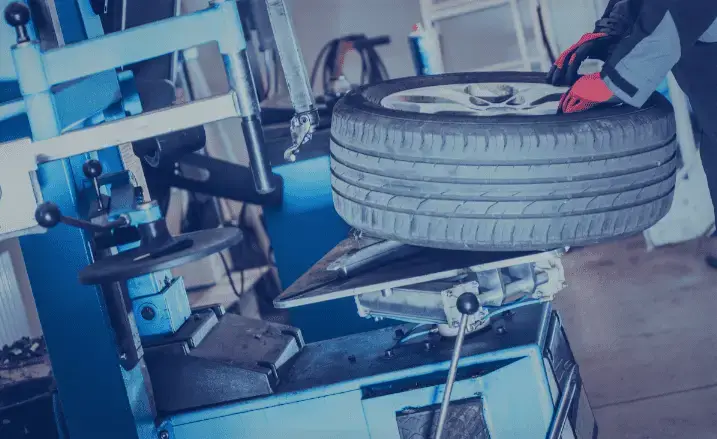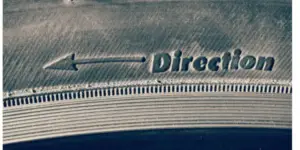Many people concentrate on their tire tread depth and don’t worry about potential damage to the sidewall of their tires. Not you, though!
A damaged sidewall is more dangerous than having a low tread and, on most occasions, should be replaced ASAP.
The sidewall’s job is to keep the tire rigid. To do this, it needs to be structurally sound. When damaged, it may not be able to support the weight of the car and could collapse, causing a blowout.
There are four types of sidewall damage; we will explore each below, along with how dangerous each one is.
Often sidewall damage is more noticeable inside the tire than you can see on the outside. At the very least, all tires with sidewall damage should be taken off the wheel or rim and inspected at a tire shop.
Is Sidewall Damage Dangerous?
Cuts and Holes In The Sidewall

Cuts, nicks, or slashed sidewalls can happen when another car’s tires kick up sharp debris like nails that smash into our car tires at speed.
Other times it can be an act of vandalism, but this is rare.
A small nick is usually nothing to worry about as it won’t have structurally damaged the tire, whereas a tire with an object such as a nail or screw embedded into the rubber will need to be replaced just in case.
Cracks In The Sidewall
There are two types of cracks.
Weather cracks – small, shallow cracks caused by the sun drying out the rubber. Usually apparent in older tires in sunnier states.
Deeper, wider cracks appear on the shoulder of the tire – the area between the tread and the sidewall. This damage is called separation and is usually caused by a manufacturing fault.
These cracks are dangerous and could cause the tread to separate from the sidewall and cause an accident. You should not drive on a tire that is separating and instead replace it.
Scuffs On The Sidewall
Hitting a curb is the likely cause of your sidewall being scuffed. It happens a lot and usually at low speeds. The scuffed area means that the sidewall was pushed inwards at the time of impact before bouncing back to its correct position on the rim.
A tire that is inflated to the correct psi and in good condition may be able to absorb this impact with no long term effects.
What looks okay on the outside may not be replicated inside the tire. It would be best if you got your tire inspected.
If you notice that your tire has wear marks around the circumference of the sidewall and looks flat, you may have been driving partially on the sidewall rather than the tread.
Low air pressure will cause the sidewall to sink as the tire’s surface area increases due to insufficient air to maintain its rigidity.
This tire isn’t structurally sound and needs to be replaced. Simply inflating the tire to the correct pressure will not fix it. The tire is dangerous.
Bubble or Bulge Sidewall
A bulge or bubble in a sidewall means the tire’s rigidity has been damaged. There is no if, and buts here, or is it okay or not to drive? It isn’t okay, and it is dangerous.
If you drive on a bubble or bulge in your sidewall, it could blowout at any time. The air inside your tire will – especially when warmed through driving – push this bubble out further, and eventually, it will rip open, and the air will escape.
A bubble or bulge on the sidewall should not be driven on and replaced immediately.
When Should I Replace A Tire With Sidewall Damage?
If your car has major sidewall damage, replace the tire.
Ask a tire shop for their opinion if the car tire has minor damage. Even if they deem the tire to be undamaged, you may want to buy a new one if it is at the end of its lifespan.
Usually, a tire reaching 5/32 inches of tread left only has a few thousand miles before a new tire is needed.

The sidewall is not very thick but does an important job. The tread has steel belts and cords underneath to add structure.
The sidewall doesn’t have these, as it needs to flex when you drive over bumps and uneven roads.
Does A Tire Warranty Cover Sidewall Damage?
Tire Manufacturers Warranty
All tire manufacturers have to offer a minimum warranty that covers damage caused by faulty manufacturing.
A sidewall that has or has started to become separated from the tread could be covered by this warranty. A bulge that had not resulted from a collision but appeared without outside influence could also be covered.
Road Hazard Warranty
Tire retailers, as an optional extra, often sell road hazard warranties. If you have this cover, you have an additional cover over and above the tire manufacturer’s warranty. You will now be covered for accidental damage as well.
A typical road hazard tire warranty
Most road hazard warranties are similar. Most will state that sidewall abrasions aren’t covered as this indicates either the tire had hit a curb and is, therefore, the fault of the driver or the tire was driven when it was underinflated. Again the fault of the driver.
Air leaks caused by nails will be covered under a road hazard policy which is the major benefit.
Conclusion
Any sidewall damage should be inspected at the tire shop, no matter how insignificant it looks from the outside. Often it’s not until the tire is taken off the rim that the full extent of the damage is apparent.
Any bulges, bubbles, large cracks, or nails that have penetrated the sidewall require the tire to be replaced immediately and the tire not driven on.




![Is It Cheaper To Buy All 4 Tires At Once? [ANSWERED IN FULL] sun-causes-tires-to-dry-out](https://carzaza.com/wp-content/uploads/2023/12/sun-causes-tires-to-dry-out-300x150.png)
![How Much Do Car Tires Weigh? [ANSWERED] summer-tires](https://carzaza.com/wp-content/uploads/2024/02/summer-tires-300x150.png)
![How Long Do New Tires Take To Put On? [ANSWERED] Torque-wrench-tire](https://carzaza.com/wp-content/uploads/2023/12/Torque-wrench-tire-300x150.png)






